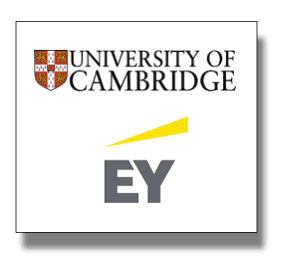 Since late November, The University of Cambridge teamed up with EY, the global professional services organization, and launched the European Alternative Finance Benchmarking Survey with the support of major European industry associations. As readers may know, this is the largest study to date on crowdfunding, peer-to-peer lending and other forms of alternative finance in Europe. This benchmarking survey, which closed on 6 January 2015, aims to capture the size, transactional volume and growth of the alternative finance markets across Europe. To date, according to Bryan Zhang, PhD Researcher in Crowdfunding & Alternative Finance at The University of Cambridge, 201 crowdfunding/ P2P lending platforms survey responses from 26 European countries have been submitted and plenty more Crowdfund Insiders around the world eagerly await the survey’s findings. In the mean time, readers have the opportunity to review European thought leaders’ incisive insight regarding alternative finance.
Since late November, The University of Cambridge teamed up with EY, the global professional services organization, and launched the European Alternative Finance Benchmarking Survey with the support of major European industry associations. As readers may know, this is the largest study to date on crowdfunding, peer-to-peer lending and other forms of alternative finance in Europe. This benchmarking survey, which closed on 6 January 2015, aims to capture the size, transactional volume and growth of the alternative finance markets across Europe. To date, according to Bryan Zhang, PhD Researcher in Crowdfunding & Alternative Finance at The University of Cambridge, 201 crowdfunding/ P2P lending platforms survey responses from 26 European countries have been submitted and plenty more Crowdfund Insiders around the world eagerly await the survey’s findings. In the mean time, readers have the opportunity to review European thought leaders’ incisive insight regarding alternative finance.
 To recap, just in case readers are new to the series, major national and regional crowdfunding associations in France, Germany, Spain, Italy, the Netherlands, the Nordic countries and the UK are participating in this groundbreaking research. This benchmarking survey is supported by FPF, ANACOFI and AFIP (France), the German Crowdfunding Network, the Spanish Crowdfunding Association, Crowdfunding Hub (Dutch), AISCRIS (Italy), the Nordic Crowdfunding Alliance, the UK Crowdfunding Association, the P2P Finance Association, the European Crowdfunding Network, the European Equity Crowdfunding Association as well as the P2P Banking.com. Crowdfund Insider initiated the exclusive interviews with The University of Cambridge’s Dr. Mia Gray and her esteemed colleague Bryan Zhang, who helped bring this exciting nascent series to fruition.
To recap, just in case readers are new to the series, major national and regional crowdfunding associations in France, Germany, Spain, Italy, the Netherlands, the Nordic countries and the UK are participating in this groundbreaking research. This benchmarking survey is supported by FPF, ANACOFI and AFIP (France), the German Crowdfunding Network, the Spanish Crowdfunding Association, Crowdfunding Hub (Dutch), AISCRIS (Italy), the Nordic Crowdfunding Alliance, the UK Crowdfunding Association, the P2P Finance Association, the European Crowdfunding Network, the European Equity Crowdfunding Association as well as the P2P Banking.com. Crowdfund Insider initiated the exclusive interviews with The University of Cambridge’s Dr. Mia Gray and her esteemed colleague Bryan Zhang, who helped bring this exciting nascent series to fruition.
European crowdfunding trailblazers interviewed to date include CrowfundingHub Founder and Executive Board Member of the European Crowdfunding Network, Ronald Kleverlaan; President of the Board of Asociación Española de Crowdfunding Daniel Oliver; Le Crowdfunding author, AFIP and ANACOFI crowdfunding expert Marianne IIZUKA; Coordinator of the German Crowdfunding Network and member of the European Crowdfunding Stakeholder Forum, Karsten Wenzlaff; Executive Director of Peer-to-Peer Finance Association, Sam Ridler; Head of the Nordic Crowdfunding Association, Dr. Rotem Shnoer; Abundance Co-Founder and UKCFA Director Bruce Davis and most recently, President of Financement Participatif France and Founder/ CEO of Unilend Nicolas Lesur.
 Claus Lehmann, my next innovative interviewee, has published P2P-Banking.com, an industry news site on P2P lending, and P2P-Kredite.com, the largest German language information resource on P2P lending frequented by German, Austrian and Swiss investors since 2007. This past November, at Lendit Europe Lehmann moderated a panel on the development of P2P lending in continental Europe. Lehmann and his informative news sites have been cited by the Financial Times, Wall Street Journal, Finanztest, German TV, Dagensit Norway, Deutsche Bank research and many other publications. Our interview follows:
Claus Lehmann, my next innovative interviewee, has published P2P-Banking.com, an industry news site on P2P lending, and P2P-Kredite.com, the largest German language information resource on P2P lending frequented by German, Austrian and Swiss investors since 2007. This past November, at Lendit Europe Lehmann moderated a panel on the development of P2P lending in continental Europe. Lehmann and his informative news sites have been cited by the Financial Times, Wall Street Journal, Finanztest, German TV, Dagensit Norway, Deutsche Bank research and many other publications. Our interview follows:
Erin: Why has P2P-Banking.com decided to participate in the Cambridge-EY European Alternative Finance Benchmarking Research?
Claus: The Nesta study ‘Understanding Alternative Finance’ has brought great insight for all participants in P2P lending and those looking to enter this field. Greater transparency is very helpful to create awareness, reduce possible reservations against these new finance offers and to increase adoption rates. It would be great if this study can achieve the same on a European instead of an ‘UK only’ level.
Erin: There are already a number of studies on Crowdfunding. How will this study differ?
Claus: I hope it will be the first comprehensive study looking at the developments on a European level. Previous studies often centered on one national market.
The rapid growth of the various sectors indicate that peer to peer lending is clearly leading the charge – yet equity crowdfunding is rather small but growing rapidly. How do you explain this phenomenon? What about peer to peer lending?
Peer to peer lending, while new, was already able to deliver predictable returns rates over the years of its existence. This does appeal to a broader audience than equity crowdfunding. With equity crowdfunding there are chances of high returns reached by some of the startups pitching; but investors need to be willing to take losses on other startups.
European p2p lending services show massive growth rates in loan originations, especially y-o-y. Growing numbers of investors embrace this method of investing and satisfaction levels are rising.
Erin: German policy is targeting digital growth as part of the “Digital Agenda 2014-2017” and the need to provide access to capital for startups, yet recent rules passed by the Federal Government may imperil investment crowdfunding in Europe’s largest single economy. How can you explain this paradox?
I think that the government feels an overly need to protect citizens from making own decisions. The proposed rules of the ‘Kleinanlegerschutzgesetz’ law will slow down the development of German equity crowdfunding platforms, but do not impact p2p lending services. The German p2p lending services are growing fast (yet not as fast as the UK or US ones) even though the regulation is much more challenging than in the UK.
Erin: What are your thoughts about companies such as Bergfürst (with its Banking license) and Fidor Bank and their approach to crowdfunding?
Claus: Fidor Bank is certainly one of the innovators in this space. It was set up from the beginning to offer a community for discussion amongst users and to offer a banking backend for fintech startups that can use the APIs offered. Bergfürst after their first funding Urbana pivoted into a new field.
Erin: What can the United States learn from Germany’s experience?
Claus: Actually I think the US can learn more by looking to the UK if they want to foster growth of this sector. The UK government has created a positive environment for the new services by introducing new regulation, offering tax incentives (EIS, SEIS, new ISAs) and lending to SMEs/investing into startups through the platforms.
Erin: How will investment Crowdfunding further spark innovation and boost entrepreneurship in Germany?
Claus: The impact is still tiny but growing and certainly startups that select this route gain visibility. It offers an additional source of financing to startup, aside other options like BAs or VCs.
Erin: In its findings regarding the role of women in alternative finance, the recent Nesta-Cambridge report states that women make up the majority of fundraisers in both donations based and rewards based crowdfunding. How will women move to match the predominantly male P2P and equity crowdfunding sector? What about other under-served segments of the population?
Claus:It will be very interesting to see what the new study finds on this.
Erin: In order for alternative finance to grow, the Nesta-Cambridge report explicitly notes “the industry needs to continue innovating, educating users and addressing the various concerns consumers and SMEs have about alternative finance.” What will be done in Germany to engender such growth?
Claus: There are several initiatives working on this, e.g. the German Crowdfunding Network. A very active community of German P2P lending investors is discussing developments in the P2P lending sector. Still a lot of more work is to be done. There is much media attention for crowdfunding and equity crowdfunding but coverage of P2P lending is still on a much lower lever than in the UK, as is public awareness.
Erin: How do you see crowdfunding evolving across Europe?
Claus: P2P lending is currently moving to the next stage. While in the past all platforms had a focus on the national market, several are now opening up for international investors and several even envision creating a pan-European marketplace. Furthermore the business models are evolving and more
products (like p2p loans secured by real estate) are gaining traction.
The Lending Club IPO also generated much interest in the sector and could have been a wakeup call to continental European banks which (with few exceptions) ignored the development of this sector. Two German banks recently reacted by setting up own incubators for fin tech startups: Commerzbank set up its incubator in March 2014 and Sutor Bank announced its strategy in summer 2014. There is also Erste Bank in Austria which has founded ‘Erste Hub’ to foster innovation. Likewise, equity crowdfunding services are looking across the borders to make their offer available to a broader European audience.
____________________________________________________________________
Crowdfund Insider has joined with The University of Cambridge to be the exclusive media partner on this benchmarking research. This interview is one of a series that includes multiple, in-depth interviews with international thought leaders and crowdfunding industry pioneers from the collaborating associations.
 For benchmarking research enquiries please contact Bryan Zhang, PhD Researcher in Crowdfunding & Alternative Finance at The University of Cambridge via email zz251@cam.ac.uk or twitter @BryanZhangZ or Robert Wardrop, Research Fellow at the Judge Business School, at The University of Cambridge at rhw40@cam.ac.uk
For benchmarking research enquiries please contact Bryan Zhang, PhD Researcher in Crowdfunding & Alternative Finance at The University of Cambridge via email zz251@cam.ac.uk or twitter @BryanZhangZ or Robert Wardrop, Research Fellow at the Judge Business School, at The University of Cambridge at rhw40@cam.ac.uk


